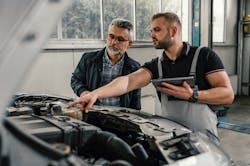By Steve Leal, President and CEO
“Each generation considers itself more intelligent than the one that went before it, and wiser than the generation that comes after it.” - George Orwell
On many occasions, I am asked this question—as head of some of the most iconic aftermarket brands, how do you engage different generations of customers? Almost every business today faces the great challenge of engaging with customers from multiple generations.
Today, we are witnessing five different generations of customers with different expectations, attitudes, communication styles and perspectives. Nevertheless, adopting an engagement approach that addresses each generation segment can help body shops remain agile and profitable in the long run.
Our customers and many of our franchise owners fall predominantly in the four major generational groups outlined below:
- Matures - those born in 1945 and before
- Baby Boomers - those born between 1946 and 1964
- Gen X - those born between 1965 and 1981
- Millennials (or Gen Y) - born in between 1982 and 2004
In these four segments, Millennials currently have the highest spending power while the others continue to remain the most loyal customers. We are smack-bang in the middle of watching a whole-new segment of consumers dictating the market.
Another upcoming generation—Gen Z (those born from 2005 to present)—forms a smaller portion of our customers but are just as important to address as they form the latest generation of motorists who own or are planning to buy their own vehicles soon. Catching them in this formative phase is key.
Engaging with each of these groups requires a good grasp of their evolving behavior. The customer is always at the heart of our operations, and we can’t employ a “One Size Fits All” approach when addressing such diverse groups. And that means not just creating robust sales and marketing campaigns, but the entire process of how we do business with them—customer service, communications, operations, in-store experience, among others.
Our own observations have shown that more than any other generation, Gen X and millennials expect their interactions with businesses to be not only fast and professional, but personalized. They just want the job done to perfection. And they’re willing to pay more for this type of experience.
Millennials were born just when high-speed Internet arrived. They are therefore more connected to technology and prefer self-service tools that save time and effort, because they would like to feel in control or empowered. Therefore, we deploy a range of omnichannel strategies to engage with this important audience—from communicating through social media platforms, to creating content that makes them think again.
On the other hand, matures and Baby Boomers will remain loyal to a brand throughout their lifetime if they receive a more personal attention from the brand. They seek value for money, are fiscally conservative and are willing to invest extra in a product or service as long as it justifies maximum return on investment.
Matures prefer traditional methods of engagement than technology, while Baby Boomers can be described as early technology adopters, optimistic, straightforward, and pretty less formal than the Matures. Engaging these the generations therefore requires a completely different type of approach. While some of them love processes that disrupt the marketplace, others prefer a more conservative approach.
Many businesses are now examining generational engagement more closely. This means adapting goods/services and other components to a specific generation. From this perspective, companies may adopt a one-generation-specialization. Other businesses prefer a multi-generational strategy where they can go beyond the unique needs of individuals belonging to the same generational group and to propose an offering that can satisfy those of more than one generation.
Personally, I am a big advocate of an “omni-channel approach” towards engaging existing and potential customers. By marrying traditional and technologically sophisticated approaches in all your engagement strategies, you can keep your body shop relevant to the customer. I believe that trying out different channels of communications with your target audience and then fine-tuning your strategies accordingly will help in boosting efficiencies, and in turn, your body shop’s bottom line.
Bridging the generational gap shouldn’t be a difficult task as long as your team understands the expectations of each generation and manages them efficiently. I believe this can create opportunities for your brands to pivot their marketing strategies and win both in the immediate term and in the longer term.
About the Author
Sponsored Content
The views and opinions expressed in this piece do not necessarily reflect those of 10 Missions Media and its associated brands.
